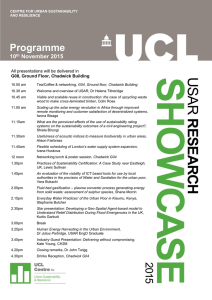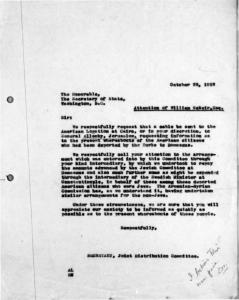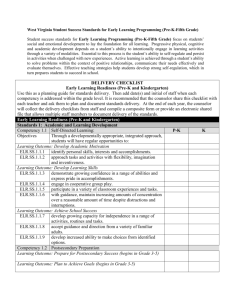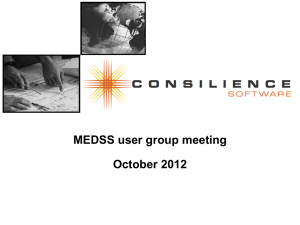White Paper The Value of Electronic Laboratory Reporting for Public Health Overview
advertisement
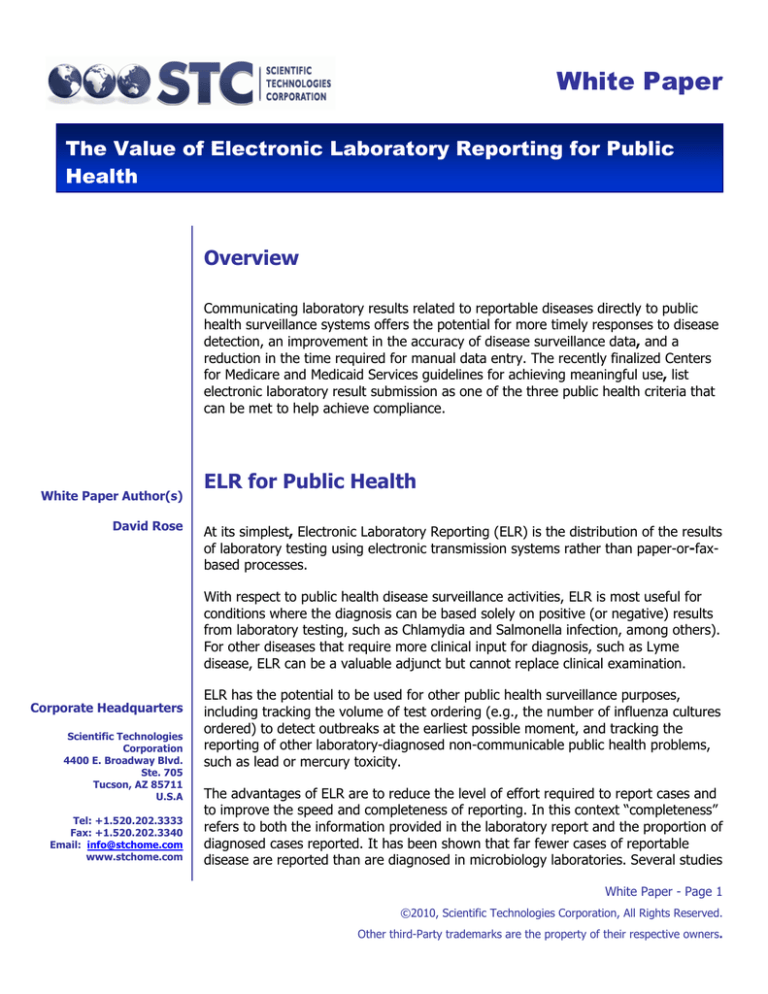
White Paper The Value of Electronic Laboratory Reporting for Public Health Overview Communicating laboratory results related to reportable diseases directly to public health surveillance systems offers the potential for more timely responses to disease detection, an improvement in the accuracy of disease surveillance data, and a reduction in the time required for manual data entry. The recently finalized Centers for Medicare and Medicaid Services guidelines for achieving meaningful use, list electronic laboratory result submission as one of the three public health criteria that can be met to help achieve compliance. White Paper Author(s) David Rose ELR for Public Health At its simplest, Electronic Laboratory Reporting (ELR) is the distribution of the results of laboratory testing using electronic transmission systems rather than paper-or-faxbased processes. With respect to public health disease surveillance activities, ELR is most useful for conditions where the diagnosis can be based solely on positive (or negative) results from laboratory testing, such as Chlamydia and Salmonella infection, among others). For other diseases that require more clinical input for diagnosis, such as Lyme disease, ELR can be a valuable adjunct but cannot replace clinical examination. Corporate Headquarters Scientific Technologies Corporation 4400 E. Broadway Blvd. Ste. 705 Tucson, AZ 85711 U.S.A Tel: +1.520.202.3333 Fax: +1.520.202.3340 Email: info@stchome.com www.stchome.com ELR has the potential to be used for other public health surveillance purposes, including tracking the volume of test ordering (e.g., the number of influenza cultures ordered) to detect outbreaks at the earliest possible moment, and tracking the reporting of other laboratory-diagnosed non-communicable public health problems, such as lead or mercury toxicity. The advantages of ELR are to reduce the level of effort required to report cases and to improve the speed and completeness of reporting. In this context “completeness” refers to both the information provided in the laboratory report and the proportion of diagnosed cases reported. It has been shown that far fewer cases of reportable disease are reported than are diagnosed in microbiology laboratories. Several studies White Paper - Page 1 ©2010, Scientific Technologies Corporation, All Rights Reserved. Other third-Party trademarks are the property of their respective owners. The Value of Electronic Laboratory Reporting for Public Health have documented that disease reporting is faster and more complete when ELR is utilized than without. In one example, electronic reporting of five conditions resulted in more than a doubling of the number of reports, which arrived at the public health jurisdiction an average of 3.8 days earlier than conventional reports. Other studies have shown that electronic reports were likely to have more fields completed than did paper-based reports. ELR Standards Since the electronic transmission of the report is intended to be read and processed by a computer, the results themselves must be transmitted in a form that is machine readable. Several standards are in use to help achieve such readability and portability. HL7, which is both an organization and a messaging format, defines the message format for ELR. The HL7 specification defines both the structure of the message and the vocabulary that should be used to provide the semantic interoperability that is necessary to allow for the results to be understandable between the sending and receiving systems. Some of the standards that govern the use of ELR for public health are listed in the table below. Table 1: Standards that govern the use of ELR STANDARD EXPLANATION OF USE HL7 – Health Level Seven The definitive guideline for ELR message structure and content is maintained by the HL7 organization. The most recent version of the specification document, entitled ‘Implementation Guide: Electronic Laboratory Reporting to Public Health, Release 1 (US Realm) HL7 Version 2.5.1: ORU^R01’, establishes the message format and, for many fields, specifies the set of allowable values that must be used. LOINC - Logical Observation Identifiers Names and Codes LOINC provides a set of universal codes and names to identify laboratory and other clinical observations. Its intent is to create a standard naming convention to facilitate the exchange of clinical results. The LOINC codes are maintained by the Regenstrief Institute and are freely available. The HL7 implementation guide for ELR specifies the use of LOINC for White Paper - Page 2 ©2010, Scientific Technologies Corporation, All Rights Reserved. Other third-Party trademarks are the property of their respective owners. The Value of Electronic Laboratory Reporting for Public Health STANDARD EXPLANATION OF USE identifying the type of test associated with the laboratory results. SNOMED CT – Systematized Nomenclature of Medicine—Clinical Terms SNOMED is a very comprehensive set of clinical terminology. For ELR, SNOMED is used to identify the specimen type and specimen source type, and is used for coded observation values. UCUM – Unified Code for Units of Measure UCUM is a code system intended to include all units of measures used in science, engineering, and business. The purpose is to facilitate unambiguous electronic communication of quantities together with their units. UCUM is specified by HL7 for use in ELR messaging for specifying the units of an observational value. PHINMS – Public Health Information Network Messaging System The PHIN Messaging System is not a standard, per se, but is a commonly used mechanism for sending messages from laboratories to public health organizations. It is based on ebXML, an industry standard for electronic communications that provides for security, encryption, and guaranteed delivery. PHINMS was developed by and is maintained by the CDC. Requirements for ELR Integration There are three broad technical requirements for ELR usage: a sender capable of HL7 messaging; a receiver capable of processing an HL7 message; and a transport mechanism to deliver the message from sender to receiver. 1. The ELR sender will likely be the laboratory information management system (LIMS) itself, or a 3rd-party message broker that is integrated with the LIMS, that is capable of generating an HL7 message. Regardless of the approach taken to generate the messages, the system must be capable of producing messages using the version 2.5.1 HL7 specifications to be eligible for meaningful use certification. White Paper - Page 3 ©2010, Scientific Technologies Corporation, All Rights Reserved. Other third-Party trademarks are the property of their respective owners. The Value of Electronic Laboratory Reporting for Public Health 2. The ELR receiver, for public health purposes, is likely to be a state’s disease surveillance and reporting system. Other potential receivers include electronic health record (EHR) systems and the National Healthcare Safety Network (NHSN). Discussions of those systems are outside the scope of this document. The ELR receiver must be capable of receiving and processing an HL7 message and, optionally send an acknowledgement of receipt back to the sender. 3. The process of transporting the laboratory report from sender to receiver has two main requirements: security and reliability. Security is necessary to ensure that both the sender and receiver are who they claim to be (authentication) and to ensure that the contents of the message are not viewed or modified in any way while in transit. Reliability is necessary to ensure that the message is delivered and received, or that a notification is sent if some issue has arisen that prevents a delivery to occur. One solution for transporting ELR messages is the Public Health Information Network Messaging Service (PHINMS). This is a software application maintained by the CDC that is designed to provide security through the use of digital certificates and high-grade encryption and provides guaranteed delivery between a PHINMS sender and a PHINMS receiver. It is important to note that PHINMS is not specific to ELR or HL7, and in fact is not contextually aware of the information that is being transmitted. Those messaging requirements still need to be met by the sending and receiving applications. It is also important to not minimize the needs of the receiving system to be able to “process” the incoming laboratory result. This requires more than just accepting and storing the message. In a disease surveillance system, the receipt of an electronic lab result triggers a cascading sequence of events: • The disease of interest must be determined based on the information in the message. Whether the sender is using LOINC codes, as specified by the standard, or is using local codes, the receiving system must map this information to the actual disease of interest. A system such as Scientific Technology Corporation’s (STC) Sentinel electronic disease surveillance system can “learn” over time what the correct mappings should be using an adaptive mapping algorithm, reducing the amount of manual review required and improving the accuracy. • The individual patient must be properly identified. The demographic information within the message can be compared to information stored within a Master Patient Index (MPI) to determine if that patient already exists in the system or is new to the system. • Finally, once the patient and disease are identified the receiving system needs to determine if the laboratory result is associated with an existing White Paper - Page 4 ©2010, Scientific Technologies Corporation, All Rights Reserved. Other third-Party trademarks are the property of their respective owners. The Value of Electronic Laboratory Reporting for Public Health disease case, or if a new case needs to be automatically created. In either scenario, a notification should be sent to the investigator responsible for the new or existing case. Potential Obstacles to ELR Integration A continuing challenge for broader uptake of ELR is the slow rate of adoption of the messaging and vocabulary standards that are intended to make the sharing of information easier and more useful. The meaningful use certification criteria specify that ELR must use version 2.5.1 of HL7. In a 2009 survey of public health laboratories, however, only 14% of respondents reported being capable of producing a version 2.5.1 message. This is not unexpected, given that the final 2.5.1 specification for ELR was only published in February of 2010, but it illustrates how there are numerous moving parts that need to be coordinated to accomplish ELR, both for public health in general and to achieve meaningful use goals. Vocabulary standardization is another lingering issue. Historically most laboratories developed their own set of local codes to describe their findings. Current ELR standards specify the use of LOINC for reporting the type of test being reported, but many laboratories are not yet capable of specifying results using LOINC codes, and even when they do have that capability there are substantial differences between versions of LOINC. Harmonizing these values is an important and challenging aspect of implementing ELR. While the messaging structure and vocabulary are critical elements, the need to validate an ELR process does not end there. If an electronic medical record (EMR) has been certified for ELR capabilities this should not be construed as it being ready to transmit laboratory messages in a turnkey fashion. Technically meeting the requirements is largely a matter of applying the correct messaging format and using the correct messaging protocols. Ultimately the value of ELR depends on a contextual compatibility with the receiving system. The data within the message must be valued appropriately so that the receiving system can process the information in a useful manner. White Paper - Page 5 ©2010, Scientific Technologies Corporation, All Rights Reserved. Other third-Party trademarks are the property of their respective owners. The Value of Electronic Laboratory Reporting for Public Health Steps to Integrating ELR with Public Health When initiating a project to integrate ELR with a disease surveillance system, it is critical to be aware of and begin to prepare for, the sometimes subtle inconsistencies that a standard such as HL7 allows. This is most likely to become apparent around issues of coded values, although it should be less pronounced when implementations adhere to the 2.5.1 version of the HL7 specification in lieu of earlier versions. • Organize the integration team. This should include technical and subject matter experts from the reporting laboratory, the receiving public health organization, and the vendors and/or developers of the software used at each location. • Identify the systems capabilities. Start with reporting system and identify any potential gaps with respect to meeting the messaging specifications. Similarly, identify the capabilities and potential gaps of the receiving system. Define an approach to reconciling any differences between the systems. • Test the interface. Testing will need to be done on several layers: • • Network communications: can the sender and receiver communicate, without being blocked by firewalls or other network security devices. • Message structure: are the messages properly constructed so they can be parsed correctly at the receiving end. • Message content: are coded values used in a way that has been agreed upon by both sender and receiver; are all required fields valued; etc. • Error handling: is the receiver handling errors appropriately and sending acknowledgements back to the sender with sufficient information to allow the error to be corrected. • Complete end-to-end testing: comprising all of the above, utilizing data and loads that can realistically be expected to occur in the production environment. Monitor the integration interface. Once the interface has been moved to a production environment and gone live, it is very important to follow a routine monitoring program. Numerous events can have a negative impact on the interface; such as software updates on either end that have some unintended consequences or modifications to network configurations or security protocols. Interruptions of service or a sudden increase in error responses White Paper - Page 6 ©2010, Scientific Technologies Corporation, All Rights Reserved. Other third-Party trademarks are the property of their respective owners. The Value of Electronic Laboratory Reporting for Public Health should be caught as early as possible to maintain a consistent quality of service. ELR and Patient Privacy The increased use of electronic medical records has been accompanied by an increased concern in the security of the information and the privacy of the individuals involved. Many electronic health record (EHR) and health information exchange (HIE) endeavors are struggling with how best to allow patients to opt-in or opt-out of information sharing arrangements. In the public health realm this issue is simplified somewhat by a provision of the Health Insurance Portability and Accountability Act (HIPAA). The act permits a provider to report a patient’s medical information pertaining to a communicable disease to the appropriate public health jurisdiction without the patient’s authorization. This HIPAA exemption is applicable regardless of the means used to transfer such information, whether it is by paper or electronic transmission, and whether the process is completely automated or is manually executed. ELR is covered by this rule and therefore, there are no requirements for anonymized laboratory results or otherwise stripped results of potentially identifying information. ELR and Meaningful Use In November of 2009, Congress passed the Health Information Technology for Economic and Clinical Health (HITECH) Act as part of the larger American Recovery and Reinvestment Act. Included in the HITECH Act were allocations of $18 billion through the Medicare and Medicaid reimbursement systems as incentives for hospitals and physicians who are “meaningful users” of electronic health records. In the Stage 1 Meaningful Use Objectives released by the Department of Health and Human Services in July of 2010, there are three objectives that are related to public health. Each of these are in the “menu” section of the guidelines, meaning that an eligible hospital or eligible provider must select some objectives from that list, but is not required to meet all objectives on the list. At least one of them, however, must be from the public health objectives. For reportable disease surveillance and ELR the relevant objective is as follows: White Paper - Page 7 ©2010, Scientific Technologies Corporation, All Rights Reserved. Other third-Party trademarks are the property of their respective owners. The Value of Electronic Laboratory Reporting for Public Health Table 2: Reportable Disease Surveillance and ELR Relevant Objective Meaningful Use Stage 1 Objective Meaningful use Stage 1 Measure Capability to submit electronic data on reportable (as required by state or local law) lab results to public health agencies and actual submission in accordance with applicable law and practice. Performed at least one test of certified EHR technology’s capacity to provide electronic submission of reportable lab results to public health agencies and follow-up submission if the test is successful (unless none of the public health agencies to which eligible hospital or CAH submits such information have the capacity to receive the information electronically). Certification Criterion Final Rule Text: § 170.306(g). Reportable lab results. Electronically record, modify, retrieve, and submit reportable clinical lab results in accordance with the standard (and applicable implementation specifications) specified in § 170.205(c) and, at a minimum, the version of the standard specified in § 170.207(c). *Note: the standards referred to in the certification criterion are: § 170.205(c): HL7 version 2.5.1 § 170.207(c): LOINC version 2.27 In many respects this is one of the more straightforward objectives to meet, certainly as compared to implementing computerized physician order entry (CPOE) or electronic prescribing of therapeutic drugs, both of which are in the list of mandatory objectives. Since the data is already being collected by the laboratory computer system, meeting this objective is dependent primarily on establishing the network communications and formatting the message properly, tasks which are readily done with today’s software systems. Conclusion Electronic laboratory reporting has been a valuable tool available to public health for more than a decade. Its adoption, however, has been undertaken in slow and halting steps. A lack of clear standards and a paucity of incentives for all participants have led to a situation where implementing ELR is a challenge and many organizations have not had the resources and motivation to do so. Fortunately, the landscape is changing in these regards. Improved standards that embrace both White Paper - Page 8 ©2010, Scientific Technologies Corporation, All Rights Reserved. Other third-Party trademarks are the property of their respective owners. The Value of Electronic Laboratory Reporting for Public Health public health and healthcare, improved technological platforms, and powerful financial incentives are leading to an opportunity where ELR could and should become ubiquitous within the public health realm. The inclusion of ELR as one of the requirements for meeting “Meaningful Use” criteria will result in an increased need for public health to be able to manage a growing volume of electronic data. The improvements to disease surveillance capabilities will be substantial. But the transition will not necessarily be easy. Any organization with the intention of following this path will be well served to spend time researching the subject, allow substantial time for working out the details, and work with an experienced and knowledgeable partner to bring the effort to successful conclusion. References Effler P, Ching-Lee M, Bogard A, Ieong MC, Nekomoto T, Jernigan D. Statewide system of electronic notifiable disease reporting from clinical laboratories: comparing automated reporting with conventional methods. JAMA 1999;282:1845-50. Health Information Technology: Initial Set of Standards, Implementation Specifications, and Certification Criteria for Electronic Health Record Technology; Final Rule. http://edocket.access.gpo.gov/2010/pdf/201017210.pdf HL7 Version 2.5.1 Implementation Guide: Electronic Laboratory Reporting To Public Health (US Realm), Release 1. February, 2010. Nguyen TQ, Thorpen L, Makki HA, Mostashari F. Benefits and Barriers to Electronic Laboratory Results Reporting for Notifiable Diseases: The New York City Department of Health and Mental Hygiene Experience Am J Public Health 2007;97:S142-S145 Wurtz R, Cameron B. Electronic Laboratory Reporting for the Infectious Diseases Physician and Clinical Microbiologist. Clinical Infectious Diseases 2005;40. White Paper - Page 9 ©2010, Scientific Technologies Corporation, All Rights Reserved. Other third-Party trademarks are the property of their respective owners. The Value of Electronic Laboratory Reporting for Public Health About Scientific Technologies Corporation Scientific Technologies Corporation (STC), an Arizona corporation established in 1988, provides domain expertise and information technology solutions to address complex real world problems in community, regional, state/provincial, and national public health programs. STC is committed to public health – our vision and mission is Advancing Health Outcomes through Information Technology with the goal to support worldwide disease management across all peoples and borders. STC is an industry leader in developing, implementing, and supporting jurisdictionwide public health information systems. The STC team offers a unique blend of health information technology engineers, systems architects, and developers as well as public health, clinical, and medical experts who excel in bringing state-of-the-art approaches and information to bear, while also creating new solutions, generating fresh collaborative insights, and producing an improved public health infrastructure. STC is committed to the continuous improvement of our products and services through client feedback and on-going implementation and augmentation of emerging national standards and advancements in technology. For more information, please visit www.stchome.com. White Paper - Page 10 ©2010, Scientific Technologies Corporation, All Rights Reserved. Other third-Party trademarks are the property of their respective owners.

